Food and Beverage Management: Menu Review and Redesign
VerifiedAdded on 2023/06/14
|7
|1281
|300
AI Summary
This article provides a review of the menu of Mappen Noodle Restaurant and suggests an alternative menu design. It also discusses the nutritional value of the dishes and the importance of an attractive menu design.
Contribute Materials
Your contribution can guide someone’s learning journey. Share your
documents today.
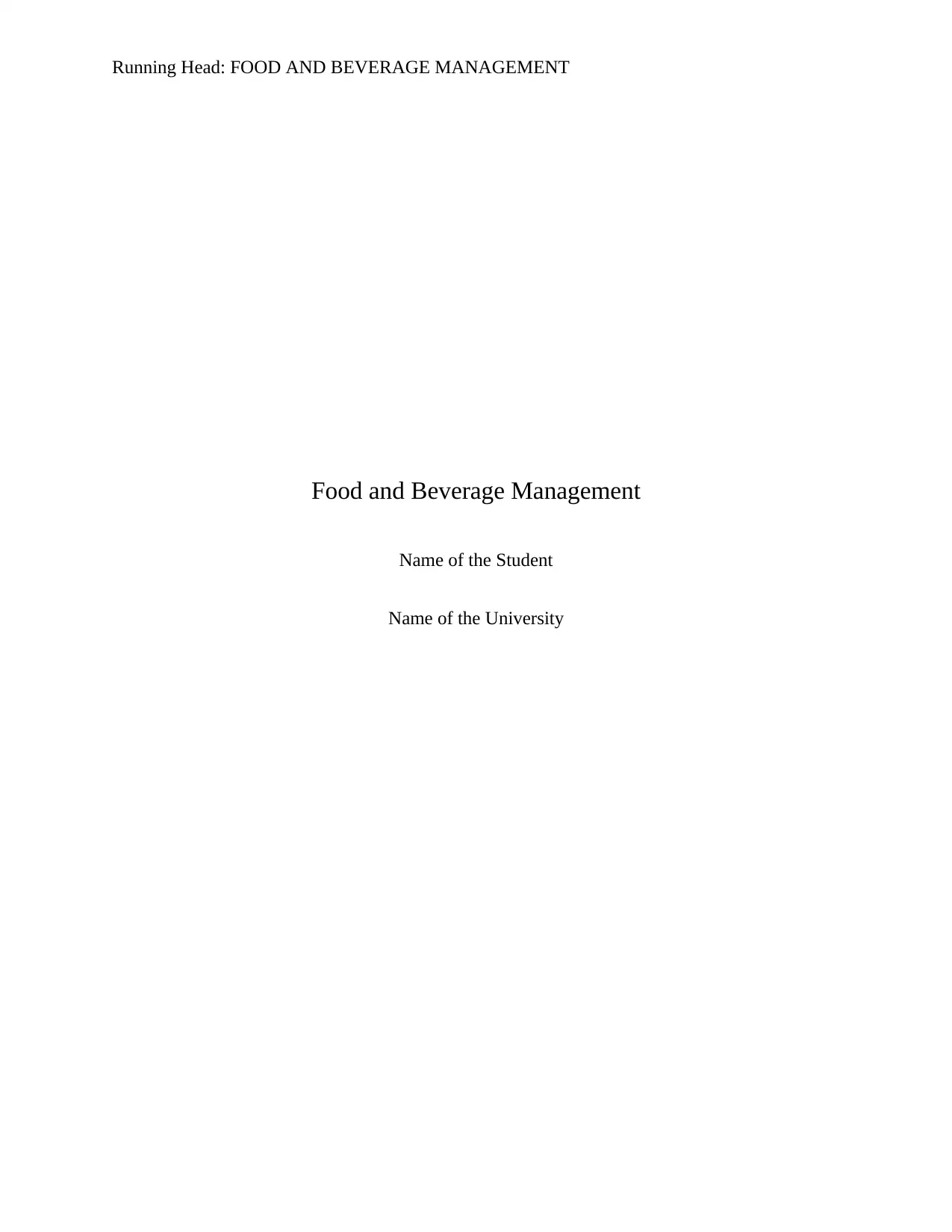
Running Head: FOOD AND BEVERAGE MANAGEMENT
Food and Beverage Management
Name of the Student
Name of the University
Food and Beverage Management
Name of the Student
Name of the University
Secure Best Marks with AI Grader
Need help grading? Try our AI Grader for instant feedback on your assignments.
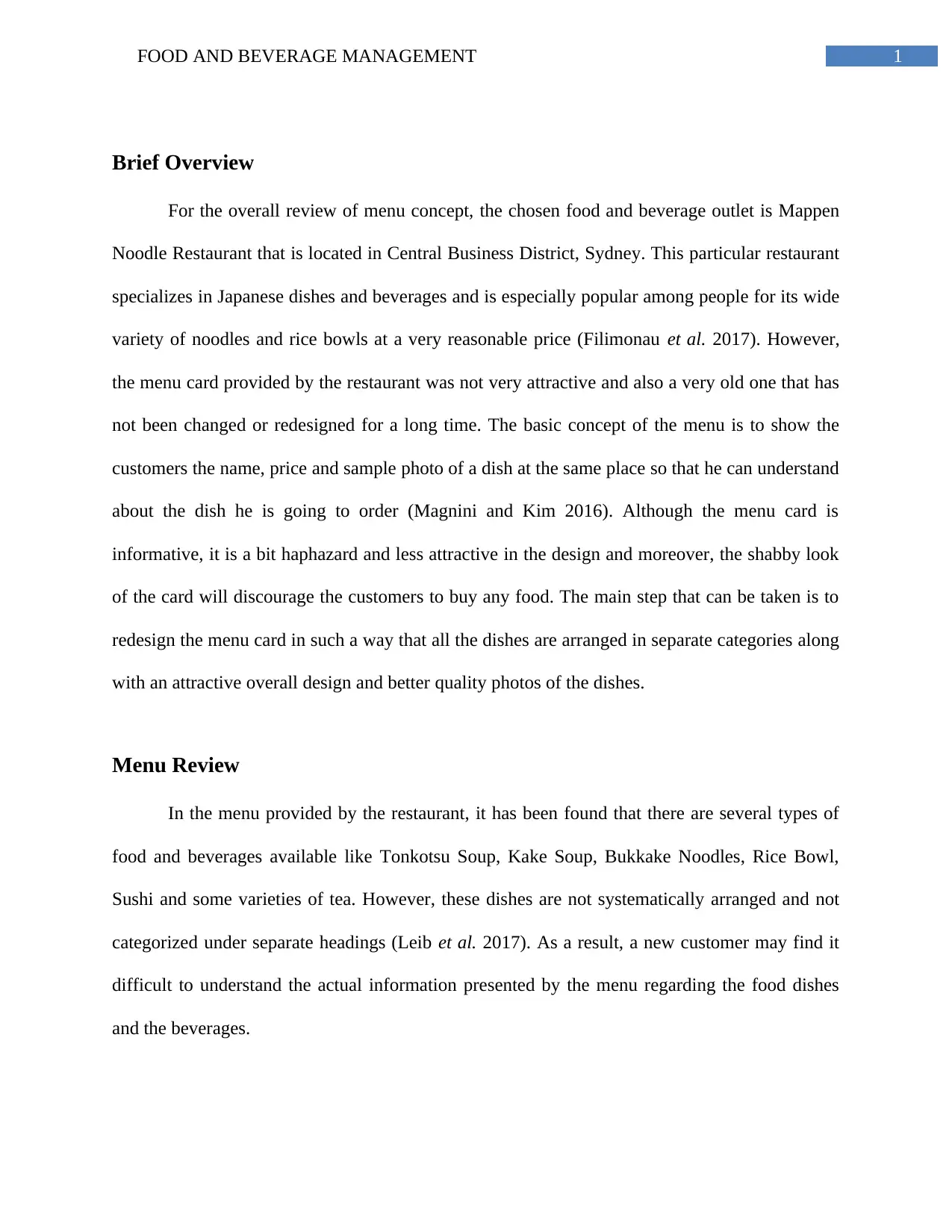
1FOOD AND BEVERAGE MANAGEMENT
Brief Overview
For the overall review of menu concept, the chosen food and beverage outlet is Mappen
Noodle Restaurant that is located in Central Business District, Sydney. This particular restaurant
specializes in Japanese dishes and beverages and is especially popular among people for its wide
variety of noodles and rice bowls at a very reasonable price (Filimonau et al. 2017). However,
the menu card provided by the restaurant was not very attractive and also a very old one that has
not been changed or redesigned for a long time. The basic concept of the menu is to show the
customers the name, price and sample photo of a dish at the same place so that he can understand
about the dish he is going to order (Magnini and Kim 2016). Although the menu card is
informative, it is a bit haphazard and less attractive in the design and moreover, the shabby look
of the card will discourage the customers to buy any food. The main step that can be taken is to
redesign the menu card in such a way that all the dishes are arranged in separate categories along
with an attractive overall design and better quality photos of the dishes.
Menu Review
In the menu provided by the restaurant, it has been found that there are several types of
food and beverages available like Tonkotsu Soup, Kake Soup, Bukkake Noodles, Rice Bowl,
Sushi and some varieties of tea. However, these dishes are not systematically arranged and not
categorized under separate headings (Leib et al. 2017). As a result, a new customer may find it
difficult to understand the actual information presented by the menu regarding the food dishes
and the beverages.
Brief Overview
For the overall review of menu concept, the chosen food and beverage outlet is Mappen
Noodle Restaurant that is located in Central Business District, Sydney. This particular restaurant
specializes in Japanese dishes and beverages and is especially popular among people for its wide
variety of noodles and rice bowls at a very reasonable price (Filimonau et al. 2017). However,
the menu card provided by the restaurant was not very attractive and also a very old one that has
not been changed or redesigned for a long time. The basic concept of the menu is to show the
customers the name, price and sample photo of a dish at the same place so that he can understand
about the dish he is going to order (Magnini and Kim 2016). Although the menu card is
informative, it is a bit haphazard and less attractive in the design and moreover, the shabby look
of the card will discourage the customers to buy any food. The main step that can be taken is to
redesign the menu card in such a way that all the dishes are arranged in separate categories along
with an attractive overall design and better quality photos of the dishes.
Menu Review
In the menu provided by the restaurant, it has been found that there are several types of
food and beverages available like Tonkotsu Soup, Kake Soup, Bukkake Noodles, Rice Bowl,
Sushi and some varieties of tea. However, these dishes are not systematically arranged and not
categorized under separate headings (Leib et al. 2017). As a result, a new customer may find it
difficult to understand the actual information presented by the menu regarding the food dishes
and the beverages.
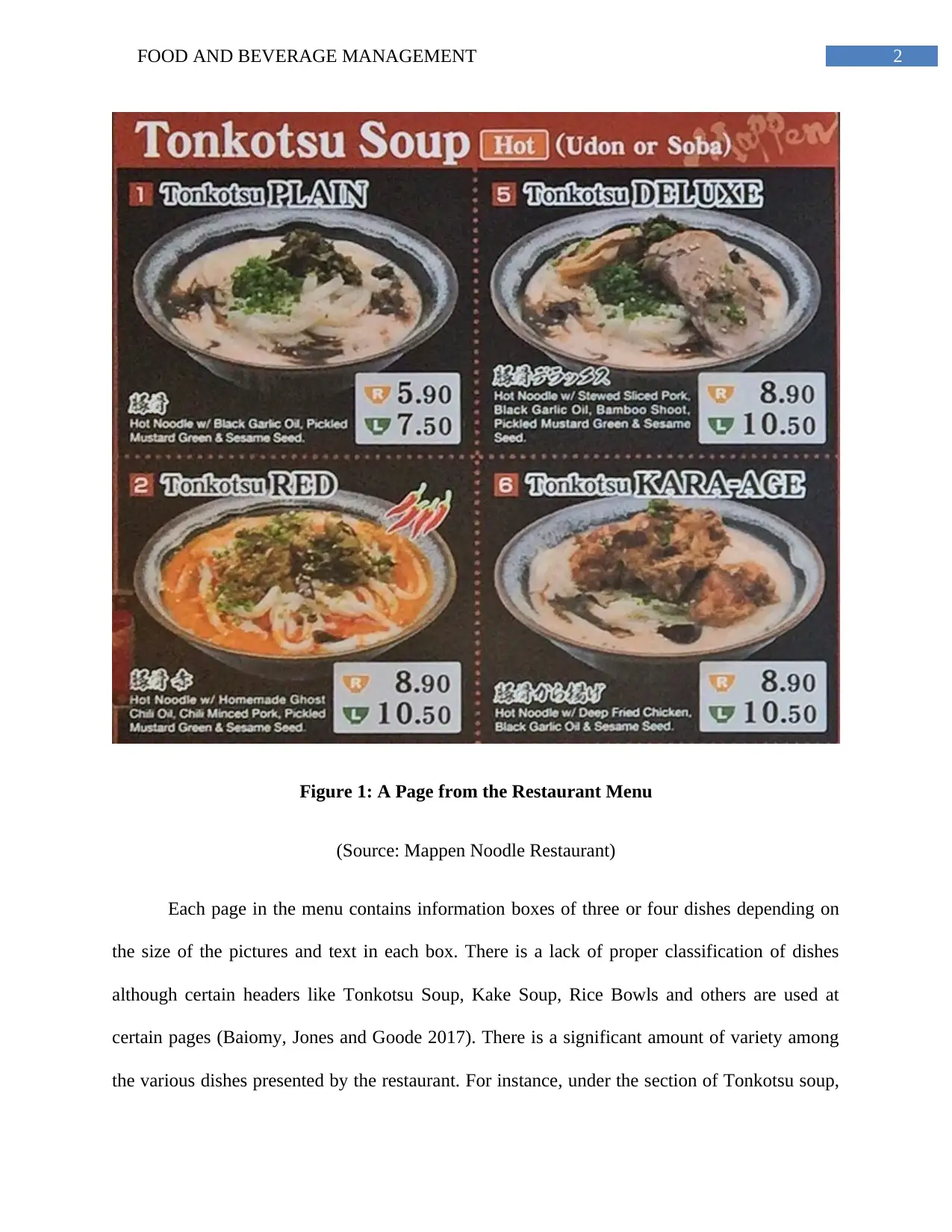
2FOOD AND BEVERAGE MANAGEMENT
Figure 1: A Page from the Restaurant Menu
(Source: Mappen Noodle Restaurant)
Each page in the menu contains information boxes of three or four dishes depending on
the size of the pictures and text in each box. There is a lack of proper classification of dishes
although certain headers like Tonkotsu Soup, Kake Soup, Rice Bowls and others are used at
certain pages (Baiomy, Jones and Goode 2017). There is a significant amount of variety among
the various dishes presented by the restaurant. For instance, under the section of Tonkotsu soup,
Figure 1: A Page from the Restaurant Menu
(Source: Mappen Noodle Restaurant)
Each page in the menu contains information boxes of three or four dishes depending on
the size of the pictures and text in each box. There is a lack of proper classification of dishes
although certain headers like Tonkotsu Soup, Kake Soup, Rice Bowls and others are used at
certain pages (Baiomy, Jones and Goode 2017). There is a significant amount of variety among
the various dishes presented by the restaurant. For instance, under the section of Tonkotsu soup,
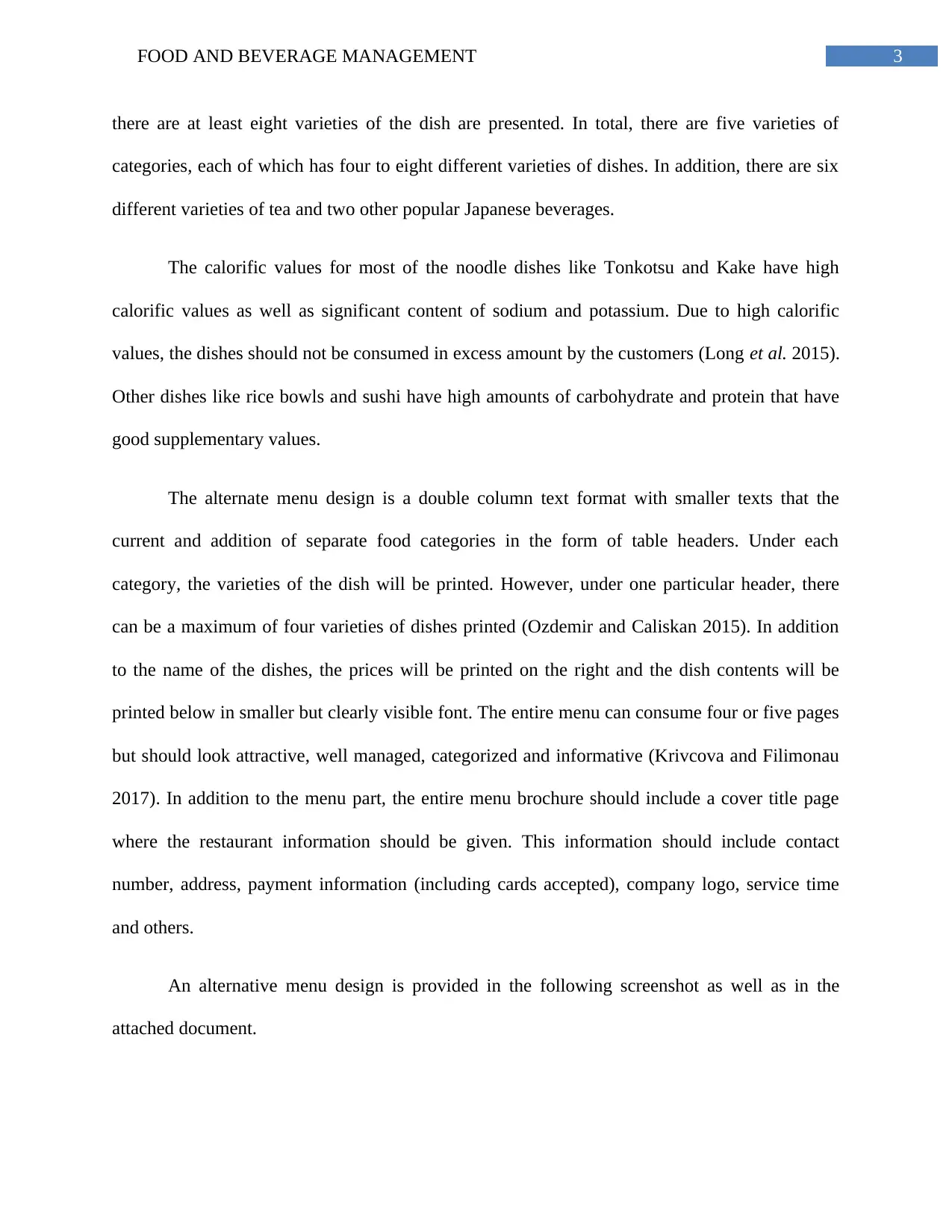
3FOOD AND BEVERAGE MANAGEMENT
there are at least eight varieties of the dish are presented. In total, there are five varieties of
categories, each of which has four to eight different varieties of dishes. In addition, there are six
different varieties of tea and two other popular Japanese beverages.
The calorific values for most of the noodle dishes like Tonkotsu and Kake have high
calorific values as well as significant content of sodium and potassium. Due to high calorific
values, the dishes should not be consumed in excess amount by the customers (Long et al. 2015).
Other dishes like rice bowls and sushi have high amounts of carbohydrate and protein that have
good supplementary values.
The alternate menu design is a double column text format with smaller texts that the
current and addition of separate food categories in the form of table headers. Under each
category, the varieties of the dish will be printed. However, under one particular header, there
can be a maximum of four varieties of dishes printed (Ozdemir and Caliskan 2015). In addition
to the name of the dishes, the prices will be printed on the right and the dish contents will be
printed below in smaller but clearly visible font. The entire menu can consume four or five pages
but should look attractive, well managed, categorized and informative (Krivcova and Filimonau
2017). In addition to the menu part, the entire menu brochure should include a cover title page
where the restaurant information should be given. This information should include contact
number, address, payment information (including cards accepted), company logo, service time
and others.
An alternative menu design is provided in the following screenshot as well as in the
attached document.
there are at least eight varieties of the dish are presented. In total, there are five varieties of
categories, each of which has four to eight different varieties of dishes. In addition, there are six
different varieties of tea and two other popular Japanese beverages.
The calorific values for most of the noodle dishes like Tonkotsu and Kake have high
calorific values as well as significant content of sodium and potassium. Due to high calorific
values, the dishes should not be consumed in excess amount by the customers (Long et al. 2015).
Other dishes like rice bowls and sushi have high amounts of carbohydrate and protein that have
good supplementary values.
The alternate menu design is a double column text format with smaller texts that the
current and addition of separate food categories in the form of table headers. Under each
category, the varieties of the dish will be printed. However, under one particular header, there
can be a maximum of four varieties of dishes printed (Ozdemir and Caliskan 2015). In addition
to the name of the dishes, the prices will be printed on the right and the dish contents will be
printed below in smaller but clearly visible font. The entire menu can consume four or five pages
but should look attractive, well managed, categorized and informative (Krivcova and Filimonau
2017). In addition to the menu part, the entire menu brochure should include a cover title page
where the restaurant information should be given. This information should include contact
number, address, payment information (including cards accepted), company logo, service time
and others.
An alternative menu design is provided in the following screenshot as well as in the
attached document.
Secure Best Marks with AI Grader
Need help grading? Try our AI Grader for instant feedback on your assignments.
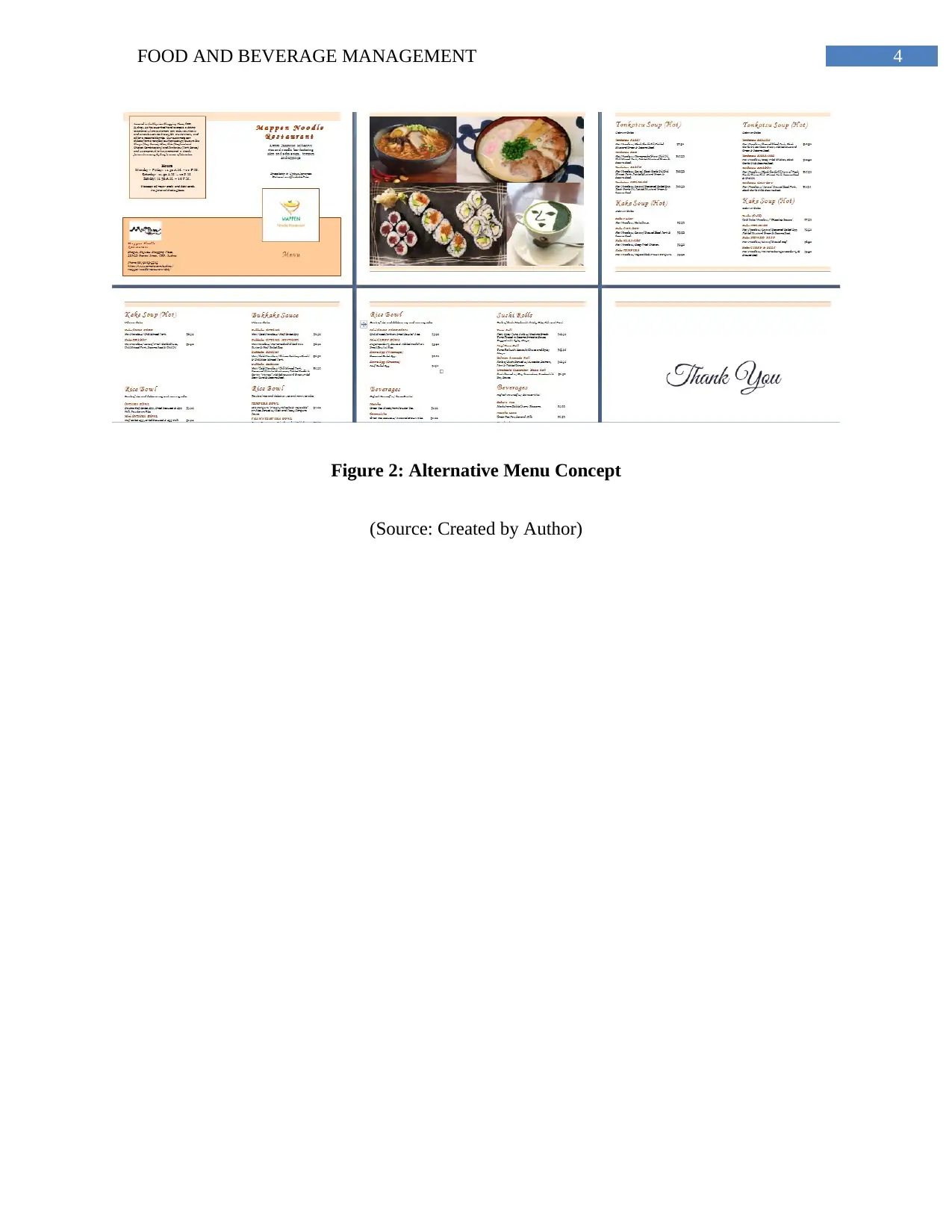
4FOOD AND BEVERAGE MANAGEMENT
Figure 2: Alternative Menu Concept
(Source: Created by Author)
Figure 2: Alternative Menu Concept
(Source: Created by Author)
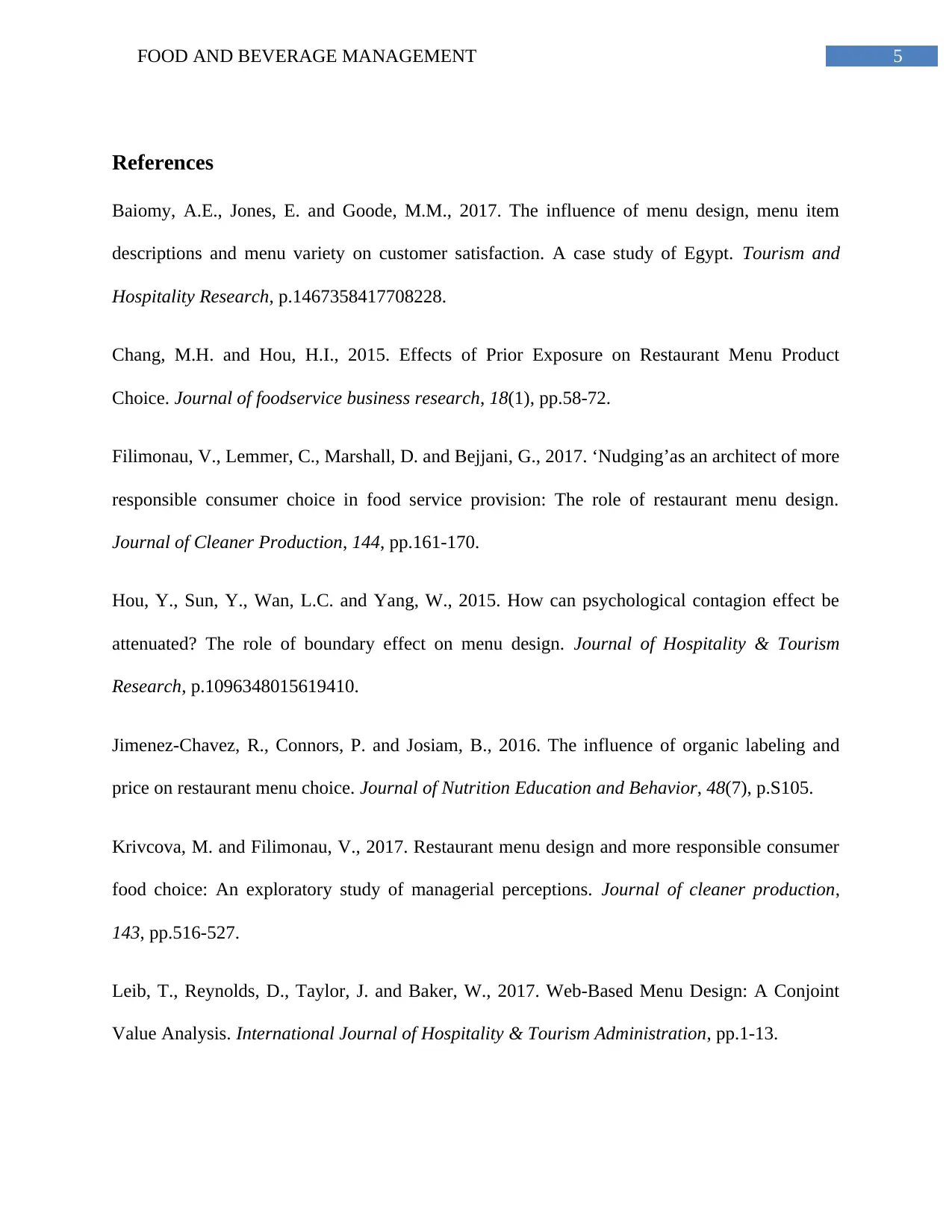
5FOOD AND BEVERAGE MANAGEMENT
References
Baiomy, A.E., Jones, E. and Goode, M.M., 2017. The influence of menu design, menu item
descriptions and menu variety on customer satisfaction. A case study of Egypt. Tourism and
Hospitality Research, p.1467358417708228.
Chang, M.H. and Hou, H.I., 2015. Effects of Prior Exposure on Restaurant Menu Product
Choice. Journal of foodservice business research, 18(1), pp.58-72.
Filimonau, V., Lemmer, C., Marshall, D. and Bejjani, G., 2017. ‘Nudging’as an architect of more
responsible consumer choice in food service provision: The role of restaurant menu design.
Journal of Cleaner Production, 144, pp.161-170.
Hou, Y., Sun, Y., Wan, L.C. and Yang, W., 2015. How can psychological contagion effect be
attenuated? The role of boundary effect on menu design. Journal of Hospitality & Tourism
Research, p.1096348015619410.
Jimenez-Chavez, R., Connors, P. and Josiam, B., 2016. The influence of organic labeling and
price on restaurant menu choice. Journal of Nutrition Education and Behavior, 48(7), p.S105.
Krivcova, M. and Filimonau, V., 2017. Restaurant menu design and more responsible consumer
food choice: An exploratory study of managerial perceptions. Journal of cleaner production,
143, pp.516-527.
Leib, T., Reynolds, D., Taylor, J. and Baker, W., 2017. Web-Based Menu Design: A Conjoint
Value Analysis. International Journal of Hospitality & Tourism Administration, pp.1-13.
References
Baiomy, A.E., Jones, E. and Goode, M.M., 2017. The influence of menu design, menu item
descriptions and menu variety on customer satisfaction. A case study of Egypt. Tourism and
Hospitality Research, p.1467358417708228.
Chang, M.H. and Hou, H.I., 2015. Effects of Prior Exposure on Restaurant Menu Product
Choice. Journal of foodservice business research, 18(1), pp.58-72.
Filimonau, V., Lemmer, C., Marshall, D. and Bejjani, G., 2017. ‘Nudging’as an architect of more
responsible consumer choice in food service provision: The role of restaurant menu design.
Journal of Cleaner Production, 144, pp.161-170.
Hou, Y., Sun, Y., Wan, L.C. and Yang, W., 2015. How can psychological contagion effect be
attenuated? The role of boundary effect on menu design. Journal of Hospitality & Tourism
Research, p.1096348015619410.
Jimenez-Chavez, R., Connors, P. and Josiam, B., 2016. The influence of organic labeling and
price on restaurant menu choice. Journal of Nutrition Education and Behavior, 48(7), p.S105.
Krivcova, M. and Filimonau, V., 2017. Restaurant menu design and more responsible consumer
food choice: An exploratory study of managerial perceptions. Journal of cleaner production,
143, pp.516-527.
Leib, T., Reynolds, D., Taylor, J. and Baker, W., 2017. Web-Based Menu Design: A Conjoint
Value Analysis. International Journal of Hospitality & Tourism Administration, pp.1-13.
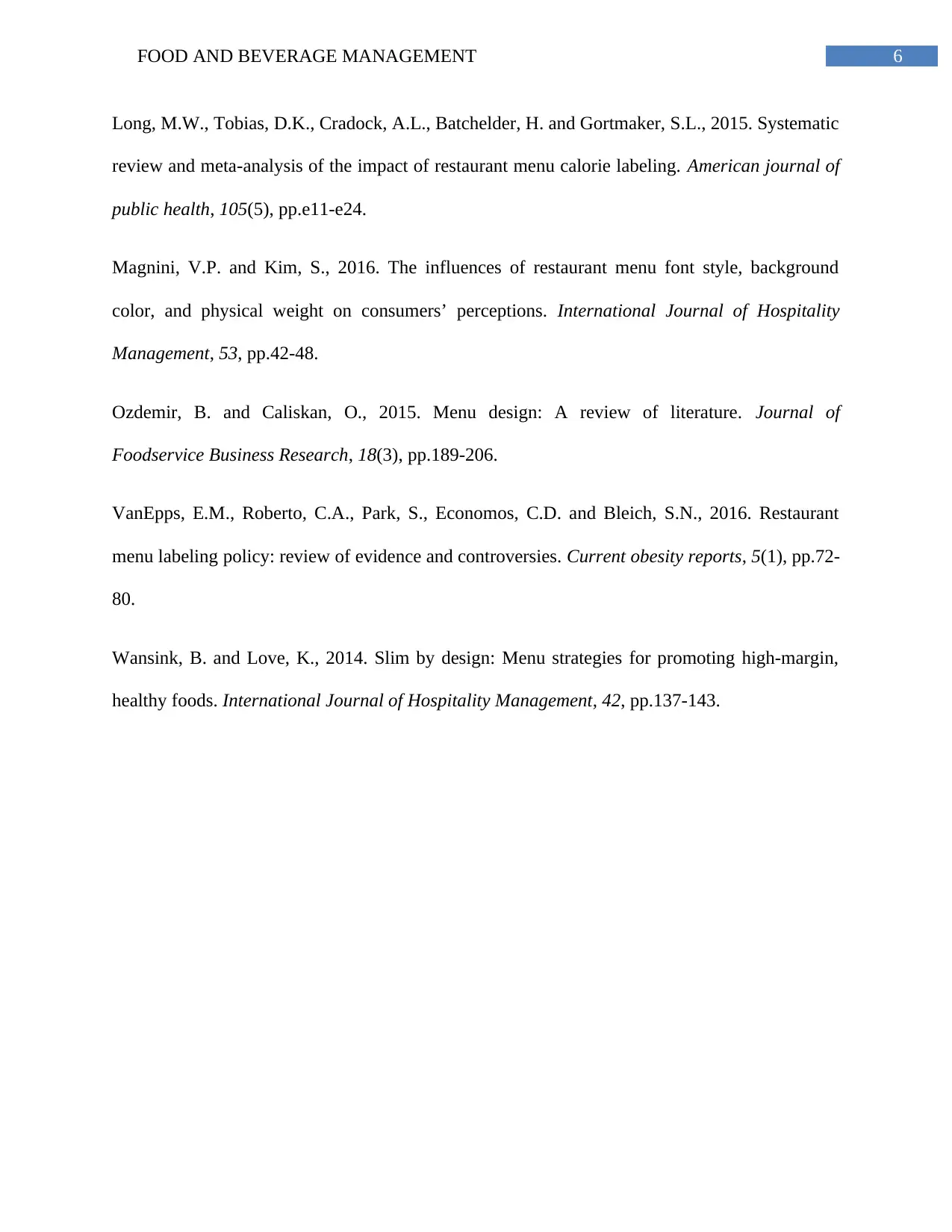
6FOOD AND BEVERAGE MANAGEMENT
Long, M.W., Tobias, D.K., Cradock, A.L., Batchelder, H. and Gortmaker, S.L., 2015. Systematic
review and meta-analysis of the impact of restaurant menu calorie labeling. American journal of
public health, 105(5), pp.e11-e24.
Magnini, V.P. and Kim, S., 2016. The influences of restaurant menu font style, background
color, and physical weight on consumers’ perceptions. International Journal of Hospitality
Management, 53, pp.42-48.
Ozdemir, B. and Caliskan, O., 2015. Menu design: A review of literature. Journal of
Foodservice Business Research, 18(3), pp.189-206.
VanEpps, E.M., Roberto, C.A., Park, S., Economos, C.D. and Bleich, S.N., 2016. Restaurant
menu labeling policy: review of evidence and controversies. Current obesity reports, 5(1), pp.72-
80.
Wansink, B. and Love, K., 2014. Slim by design: Menu strategies for promoting high-margin,
healthy foods. International Journal of Hospitality Management, 42, pp.137-143.
Long, M.W., Tobias, D.K., Cradock, A.L., Batchelder, H. and Gortmaker, S.L., 2015. Systematic
review and meta-analysis of the impact of restaurant menu calorie labeling. American journal of
public health, 105(5), pp.e11-e24.
Magnini, V.P. and Kim, S., 2016. The influences of restaurant menu font style, background
color, and physical weight on consumers’ perceptions. International Journal of Hospitality
Management, 53, pp.42-48.
Ozdemir, B. and Caliskan, O., 2015. Menu design: A review of literature. Journal of
Foodservice Business Research, 18(3), pp.189-206.
VanEpps, E.M., Roberto, C.A., Park, S., Economos, C.D. and Bleich, S.N., 2016. Restaurant
menu labeling policy: review of evidence and controversies. Current obesity reports, 5(1), pp.72-
80.
Wansink, B. and Love, K., 2014. Slim by design: Menu strategies for promoting high-margin,
healthy foods. International Journal of Hospitality Management, 42, pp.137-143.
1 out of 7
Your All-in-One AI-Powered Toolkit for Academic Success.
+13062052269
info@desklib.com
Available 24*7 on WhatsApp / Email
![[object Object]](/_next/static/media/star-bottom.7253800d.svg)
Unlock your academic potential
© 2024 | Zucol Services PVT LTD | All rights reserved.


